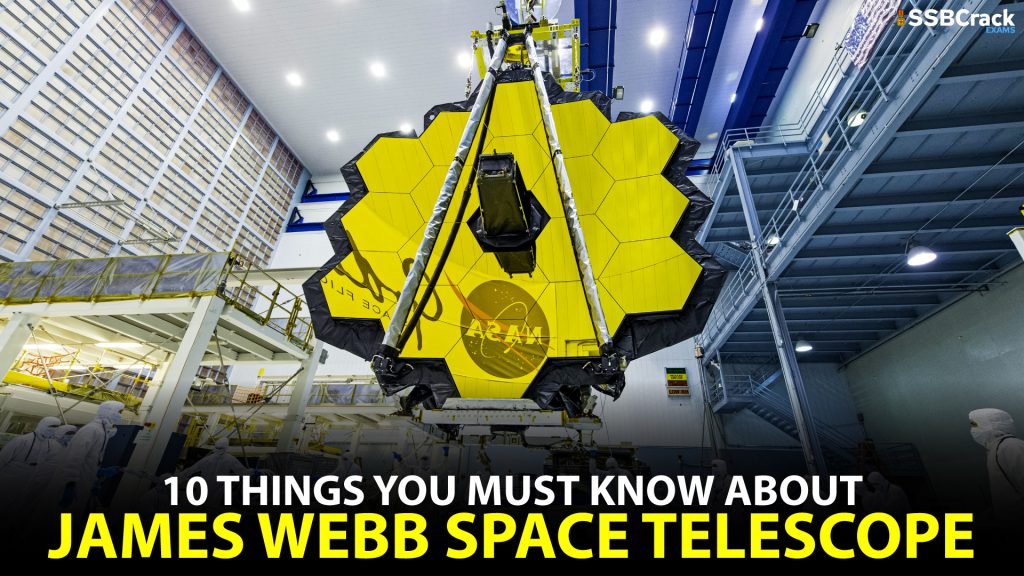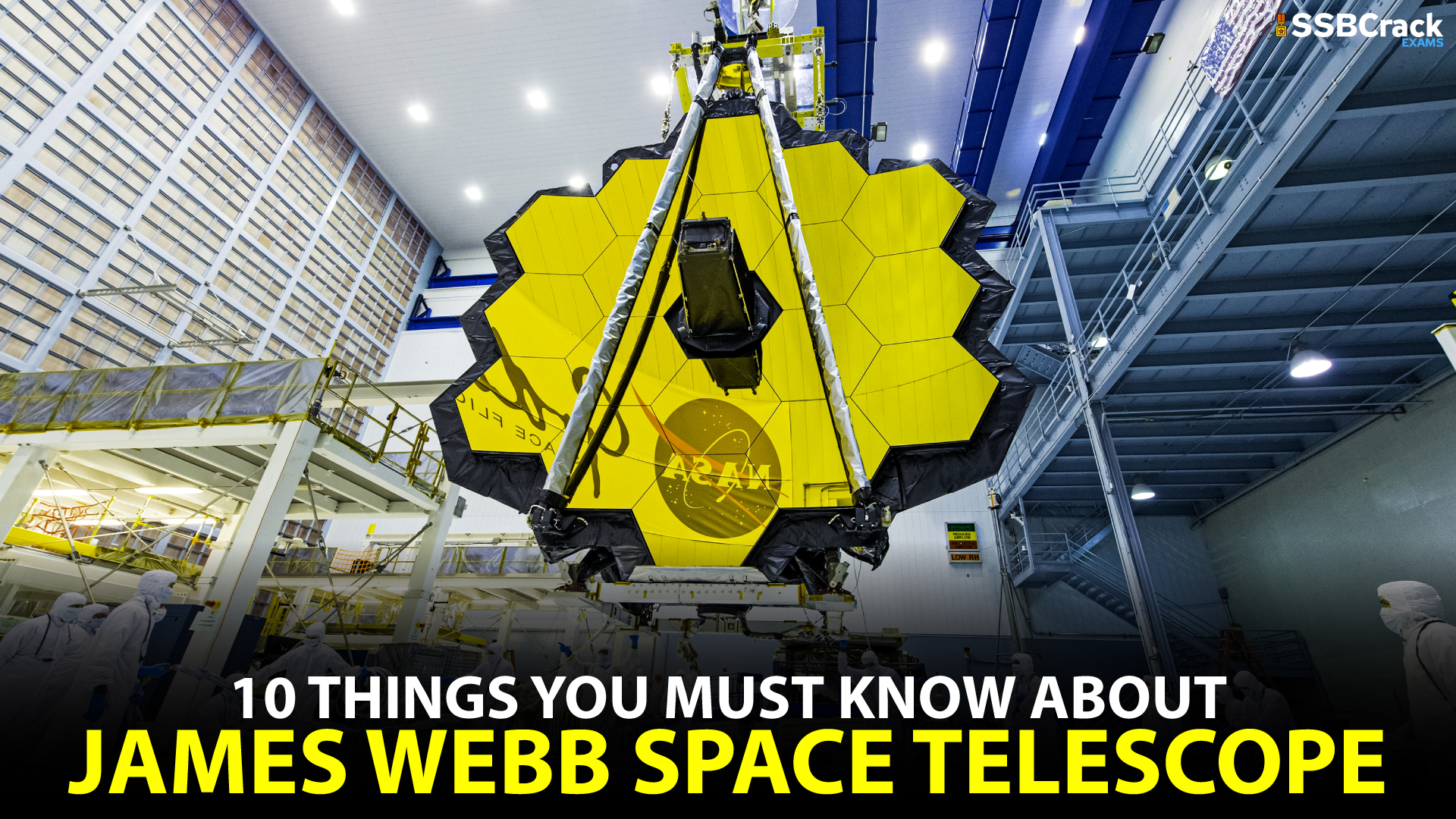
Jai Hind future warriors today we are going to discuss about the James Webb Telescope, This is important not just for your defence exams, but also for your interview, as strong general awareness reflects your curiosity to learn, an important aspect of a good personality.
- Agencies Involved
James Webb Space Telescope(JWST) has been developed by space agency NASA(National Aeronautics and Space Administration) with contributions from CSA(Canadian Space Agency) and ESA(European Space Agency). NASA gave the contract to Northrop Grumman who were assigned designing and building the deployable sunshield, providing the spacecraft and integrating the total system.
2. Naming of JWST:
Originally the mission was named as Next Generation Telescope, but it was later changed to James Webb Space Telescope, in honour of James Edwin Webb (October 7, 1906 – March 27, 1992). Webb was an American government official who served as Undersecretary of State from 1949–1952 and as the second administrator of NASA from February 14, 1961, to October 7, 1968. He oversaw all of the U.S. crewed missions throughout the Mercury and Gemini programs. He also led the first Apollo mission and left NASA, just before its launch
3. Launch of JWST
JWST was successfully launched from the Guiana Space Centre in French Guiana(on northeast coast of South America) at 12:20 UTC on December 25. The spacecraft was lifted above Earth aboard an Ariane 5 launch vehicle and is now past the Moon as it travels to its final observing point (as on 27 Dec 2021).
Note: This is the same space facility and the same rocket that the ISRO uses to lauch its heavier satellites(most recently GSAT-30)
4. Cost and Duration
JWST is one of the most expensive scientific platforms in history. The total cost is 7.2 Lakh Crore rupees and is spread out over 24 years including five years of operations. The European Space Agency, which provided the Ariane 5 rocket and two of the observatory’s four science instruments, will pay about 5900 Crore Rupees, while the Canadian Space Agency will pay about 1165 Crore rupees . That may sound like a lot, but it’s just 0.0095% of US spending during the same period – much like the price of a xerox of a single page in comparison to original price of the book. To put the timeline in general, idea of JWST was first conceived as Next Generation Telescope in 1996- Shri Narendra Modi was just a member of BJP Gujarat then, and he is serving his second term as PM when it is finally launched.
5. Mission Of JWST
The James Webb Space Telescope has four key goals:
- To search for light from the first stars and galaxies that formed in the Universe after the Big Bang
- To study the formation and evolution of galaxies.
- To observe the formation of stars from the first stages to the formation of planetary systems
- To measure the physical and chemical properties of planetary systems, including our own Solar System, and investigate the potential for life in those systems.
6. Relation with Hubble Space Telescope
JWST is an orbiting infrared observatory that will complement and extend the discoveries of the Hubble Space Telescope, with longer wavelength coverage and greatly improved sensitivity. The longer wavelengths enable Webb to look much closer to the beginning of time and to hunt for the unobserved formation of the first galaxies, as well as to look inside dust clouds where stars and planetary systems are forming today.

7. Distance
While Hubble was only 547 kilometres away from Earth, the James Webb Telescope will be millions of kilometres away from Earth – roughly four times the distance between the Earth and Moon. If some problematic issue arises in the JWST, scientists would not be able to service James Webb. However this was possible with Hubble as after they realised something was wrong with its mirror shortly after launch they were able to service it
8. The Gold Mirrors:
- The primary mirror is made of 18 hexagonal-shaped mirror segments — each 1.32 metre in diameter — stitched together in a honeycomb pattern. When fully open it will be 6.5 metre in diameter. The Hubble Space Telescope’s mirror had a diameter of just 2.4 metre
- Each mirror segment weighs approximately 20 kilograms and is made from beryllium. Beryllium was used as it is both strong and light.
- After the beryllium mirror segments were polished a thin coating of gold was applied to it. Gold helps improve the mirror’s reflection of infrared light. The gold was coated using a technique called vacuum vapour deposition. The mirrors are kept inside a vacuum chamber and a small quantity of gold is vapourised and deposited on the mirror. The thickness of the gold is just 100 nanometers. So less than 50 grams of gold was used for the entire mirror.
Note: These minute details are not much useful for the exams, but if in your PIQ you mentioned your hobby/interests as astronomy, then you will know this is currently the biggest thing in sphere of astronomy as of now.
9. Sunshield of JWST
The James Webb Space Telescope (JWST) incorporates a sunshield. It will extend out post-launch unfolding a large metal-coated sheet of material. The material is designed to shield the main optics from the Sun’s light and heat, so the telescope can see the faint light coming from distant stars and galaxies. The sunshield segment includes the layers and its deployment mechanisms, which also includes the trim flap
The Infrared Range
Stars and planets that are just forming lie hidden behind cocoons of dust that absorb visible light. (The same is true for the very center of our galaxy.) However, infrared light emitted by these regions can penetrate this dusty shroud and reveal what is inside. Hence JWST has a big advantage over Hubble(whose primary capabilities was in U-V and visible regions) as Webb’s instruments will work primarily in the infrared range of the electromagnetic spectrum, with some capability in the visible range. This will help in more clear pictures focussing on distant objects which are otherwise covered by dust.

10. Look Back in Time
Understand this first: Light travels at the speed of 3*108 m/s, and we know that sun rays take 8 minutes to reach to us, this means that we see the Sun as it was 8 minutes ago. The closest galaxy to us Andromeda, is about two-and-a-half million light-years away, which means that the light which we see today from Andromeda started its journey two-and-a-half million years ago from there.
Thus, JWST was made to see very far off objects, as they are much light years away from us and we will be able to see them much more back in time and know about their formation and evolution.
Conclusion
Hope this was informative to you. For more posts like these related to defence exams and SSB Interview stay tuned.
Jai Hind



















